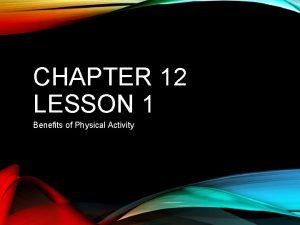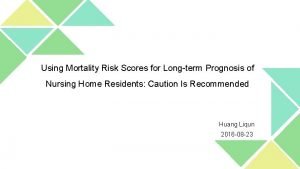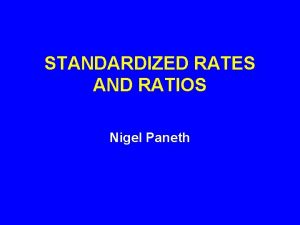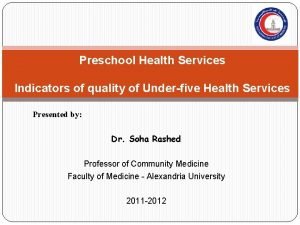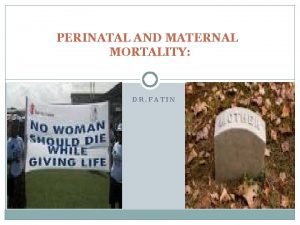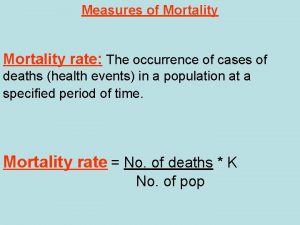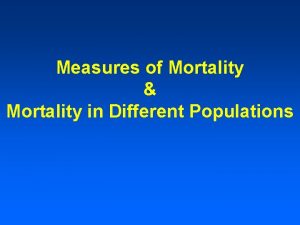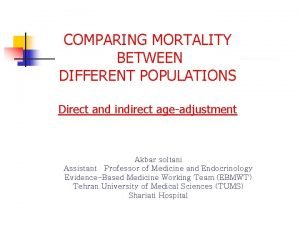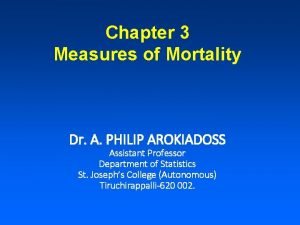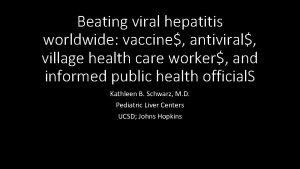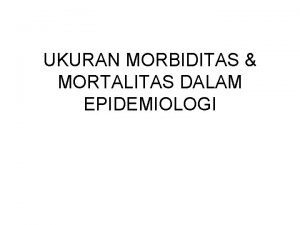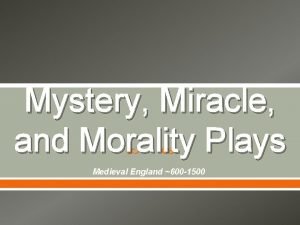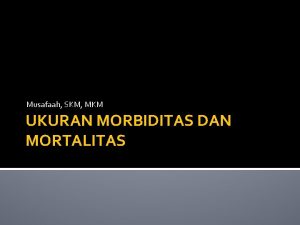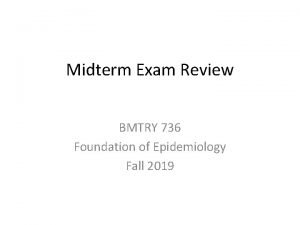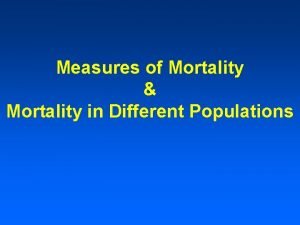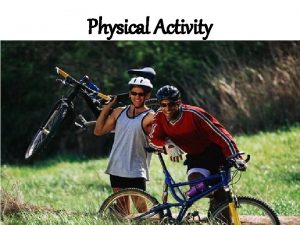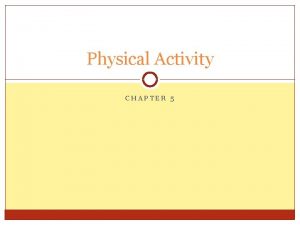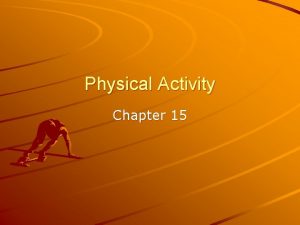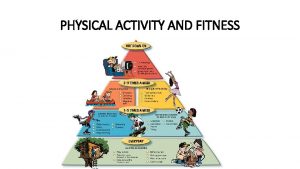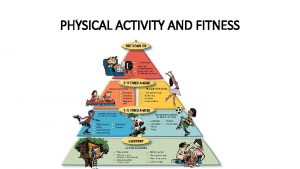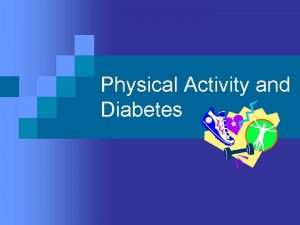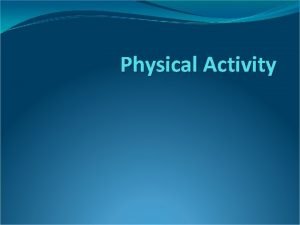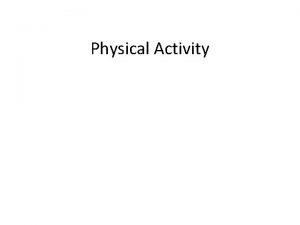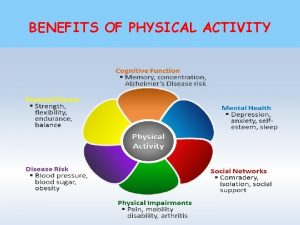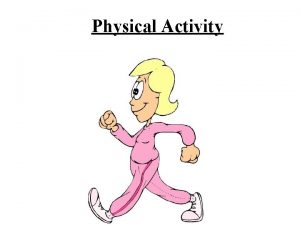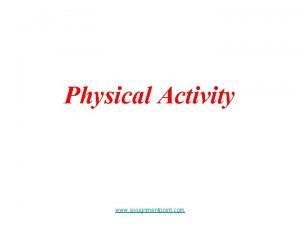Chapter 3 Physical activity and mortality Chapter overview






















- Slides: 22

Chapter 3 Physical activity and mortality

Chapter overview • Physical activity and mortality • Physical fitness and mortality • Changes in physical activity and mortality • Changes in physical fitness and mortality • Activity, fitness, body composition and mortality • Combined healthy lifestyle behaviours and mortality • Exercise and longevity • Summary

The question. . . Can physical activity and physical fitness reduce the risk of dying prematurely? This chapter attempts to answer this question, based on evidence from epidemiological cohort studies.

Physical activity in leisure time and risk of all-cause mortality

Energy expended in physical activity (doubly labelled water) and mortality

Physical activity and mortality • Studies, mainly based on questionnaire data, are reassuringly consistent. • Risk of inactivity is independent of other known major risk factors. • Study with an objective measure (doubly labelled water) showed that the high-active group had only one-third of the risk of dying, compared with the least active.

Quintiles of fitness (treadmill time) and mortality risk Men Women Relative risk Fitness group 1 (low) 3. 44 4. 65 2 1. 37 2. 42 3 1. 46 1. 43 4 1. 17 0. 76 5 (high) 1. 00

Relative risk associated with low fitness compared with risks for established risk factors

Exercise capacity (METs) inversely related to risk in men with and without CVD Note: Each 1 MET increase in capacity associated with 12% increase in survival.

Low fitness is a risk factor even in subgroups already at high risk

Studies of fitness and mortality consistently show. . . • protective effect of fitness; • evidence for dose–response; but • studies are observational; • there is the problem of genetic influence on fitness.

Changes in activity level over time are associated with change in risk

Changes in fitness over time are associated with change in risk

Low fitness a risk factor across different categories of % body fat

Low fitness a risk factor across different categories of waist circumference

Among obese men, risk for low fitness similar to established risk factors

In obese men, PAR for low fitness is higher than that for other risks

Mortality risk associated with combined healthy behaviours Healthy behaviours • Mediterranean diet • moderate alcohol • non-smoking • physically active

Energy expenditure of activity and longevity • Energy expenditure equivalent to minimal adherence to guideline (‘ 30 minutes or more of moderateintensity physical activity on most, preferably all, days of the week’) is associated with 20– 30% reduction in mortality risk. • Clear evidence exists for inverse dose–response between level of risk and ‘volume’ of activity. • The effect is observed in men and women, younger and older persons. • The effect is stronger for fitness than for physical activity, but this may be explained by greater objectivity with which fitness is measured.

Summary I • Physical activity and physical fitness are inversely related to all-cause mortality risk in observational studies. • The effect is still present after control for possible confounding. • Most studies have been conducted in Caucasian populations. Data on other ethnic groups are limited. • Mortality rates are between 20% and 80% lower in the active/fit, compared with the inactive/unfit. • Evidence strongly suggests a dose–response relationship. • Association between fitness and mortality risk is similar to or stronger than that for other established disease risk factors.

Summary II • The association between physical activity/fitness and mortality holds true for adult men and women of all ages. • Obese individuals who are physically fit have a similar risk as lean individuals who are physically fit. Physical activity may provide important health benefits for the obese. • Expending 4, 200 k. J week– 1 (1, 000 kcal week– 1) in physical activity is sufficient to lower all-cause mortality risk, but greater amounts and intensities of activity are likely to confer greater benefits.

Summary III • Although physical activity and physical fitness are associated with the prevention of premature mortality, they do not appear to extend the natural lifespan. • Combining physical activity with other healthy lifestyle behaviours appears to provide greater protection from disease than activity alone. • Plausible biological mechanisms that may explain the association between physical activity/fitness and all-cause mortality will be discussed in the chapters that follow.
 Physical fitness grade 9
Physical fitness grade 9 Morbidity and mortality
Morbidity and mortality Chapter 12 physical activity and fitness
Chapter 12 physical activity and fitness A physical education chapter 12
A physical education chapter 12 Flacker score
Flacker score Great gatsby themes
Great gatsby themes Disease specific mortality rate formula
Disease specific mortality rate formula Infant mortality rate formula
Infant mortality rate formula Perinatal mortality rate
Perinatal mortality rate Mortality rate formula
Mortality rate formula Death rate formula
Death rate formula Indirect age adjustment
Indirect age adjustment Age adjusted mortality rate
Age adjusted mortality rate Attributable mortality
Attributable mortality Calculate relative risk
Calculate relative risk Continuous mortality investigation
Continuous mortality investigation Ukuran mortalitas
Ukuran mortalitas Infant mortality rate formula
Infant mortality rate formula Morality miracle and mystery plays
Morality miracle and mystery plays Infant mortality rate formula
Infant mortality rate formula Rumus angka kematian
Rumus angka kematian An epidemiologic survey of roller skating injuries
An epidemiologic survey of roller skating injuries Death rate formula
Death rate formula



